
Building a learning culture has always been a strategic priority for CHROs. Yet in most organizations, it remains more of a slogan than a system. Values like curiosity, growth, and continuous learning often look inspiring on posters but rarely influence how people actually work or make decisions.
That gap exists because culture doesn’t grow by inspiration; it grows by design. It needs structure, reinforcement, and accountability. In other words, building a learning culture is less about communication campaigns and more about engineering an operating system.
Like any OS, it runs silently in the background, shaping how people think, collaborate, and respond to change. If that system isn’t consciously designed, it defaults to inertia, and when that happens, learning becomes an event to attend, not a capability to live.
That mindset shift captures what today’s CHROs must enable: a culture where curiosity, reflection, and experimentation are built into the way people work every day.
That’s where the idea of a Learning Culture Operating System (LCOS) comes in. A well-designed LCOS hardwires learning into the fabric of daily work through observable behaviors, consistent rituals, and business-relevant metrics.
As an architect of capability, the CHRO’s mission is to engineer an OS that helps people learn how to learn. In such organizations, knowledge doesn’t sit in silos; it flows freely across teams, strengthening collective intelligence and decision quality.
The blueprint that follows shows exactly how to design and install this Learning Culture Operating System (LCOS) layer by layer. So learning becomes as natural, measurable, and essential as performance itself.
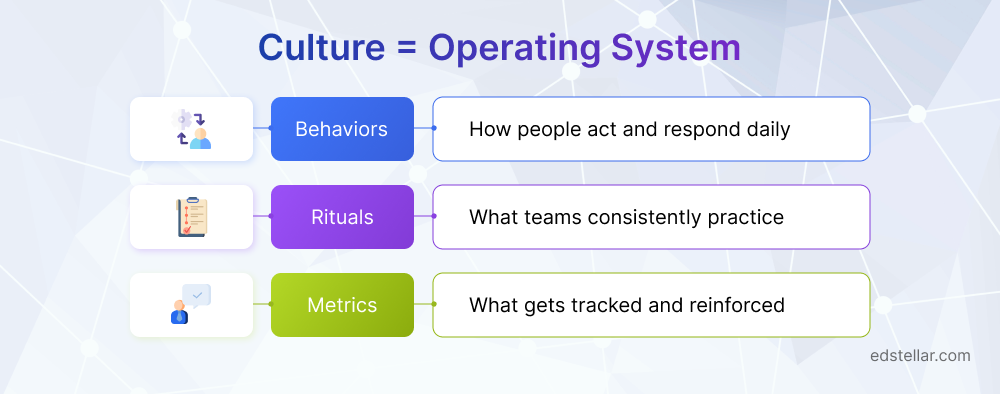
Why a Learning Culture Operating System is a Strategic Imperative for CHROs
Markets today are ruthlessly rewarding organizations that can absorb new capabilities faster than their competitors, especially in the age of AI. Yet despite heavy spending on tools, many leaders still don’t see productivity in the P&L.
The issue isn’t technology; it’s architecture. In most enterprises, capability building still runs as disconnected programs. To convert spend into performance, you need an operating system, a framework that makes learning continuous, embedded, and measurable across the workflow.
This matters because companies with a healthier operating system outperform their competitors. McKinsey’s research on organizational health shows top-quartile firms deliver nearly 3× Total Shareholder Return versus the bottom quartile. A defining driver of that premium is the capacity to learn and adapt faster, precisely what an LCOS institutionalizes, linking culture directly to financial outcomes.
And the urgency is compounding. LinkedIn data shows job skill sets have already shifted by ~41% since 2015 (up from ~25% a few years earlier) and are expected to double by 2027. That trajectory makes reskilling and redeployment at scale a business-critical capability, not merely an HR initiative, and it can’t be delivered by courses alone; it requires a system embedded in the flow of work.
Forward-leaning organizations are already embedding learning directly into the flow of work. As Josh Bersin observes, the future of learning isn’t about courses; it’s about “learning in the tools and moments where work happens.” When learning becomes ambient and continuous, performance compounds naturally.
The takeaway for CHROs is clear: the half-life of skills is shrinking, AI is redefining roles, and organizational agility now depends on learning velocity. Installing a Learning Culture Operating System (LCOS) makes that advantage measurable, repeatable, and lasting.
Part 1: Behaviors The Non-Negotiable Code of Conduct
Behaviors are the source code of the Learning Culture Operating System (LCOS). They determine whether learning remains a philosophy or becomes a repeatable business habit.
These are the small, observable actions that, once modeled consistently, reshape how an organization thinks, collaborates, and improves. When designed well, these behaviors cascade: leaders model, managers reinforce, teams practice, and knowledge spreads. Together, they create the rhythm of a self-learning enterprise.
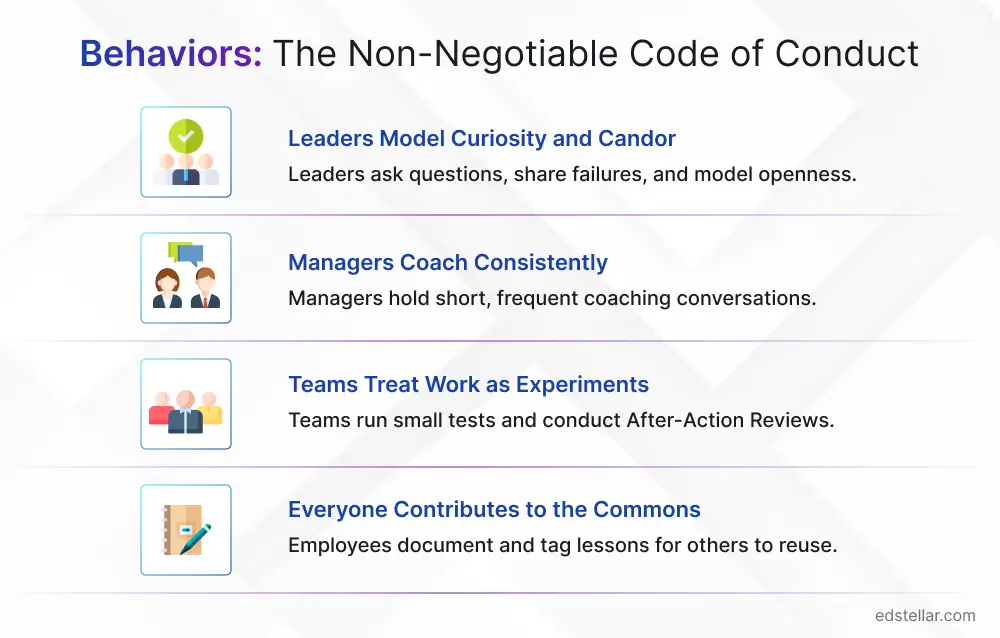
1. Leaders Model Curiosity and Candor
Change begins where visibility is highest. Executives set the tone when they ask questions publicly, admit what they don’t know, and share what recent failures have taught them.
This behavior builds psychological safety at work, the foundation of all learning cultures.
2. Managers Coach Consistently, Not Occasionally
Great managers turn learning into momentum. A 10-minute weekly coaching conversation focused on one practice, one repetition, and one next step does more for growth than a day-long workshop once a quarter.
Consistency compounds. Over time, coaching becomes the bridge between learning and performance, translating insights into behavior change.
3. Teams Treat Work as Experiments
High-performing teams operate like scientists: they start with a hypothesis, test on a small scale, and close with an After-Action Review (AAR).
This experimental rhythm transforms work into a continuous learning loop, where reflection is integrated into execution, rather than reserved for post-mortems.
4. Everyone Contributes to the Commons
Learning scales only when knowledge circulates. Every employee should document and tag solutions, templates, and lessons so that others can reuse them.
When tacit knowledge becomes findable, it transforms from individual expertise into collective intelligence. The organization starts to learn faster than any single person within it.
These behaviors make that responsibility visible. They shift learning from HR policy to leadership practice, from words on a wall to actions in motion.
Part 2: Rituals The System Processes That Make Learning Inevitable
Behaviors create intent; rituals create consistency.
If behaviors are the code of a Learning Culture Operating System (LCOS), rituals are the processes that keep that code running.
They transform learning from a one-time event into an organizational rhythm, embedding reflection, practice, and improvement into daily work.
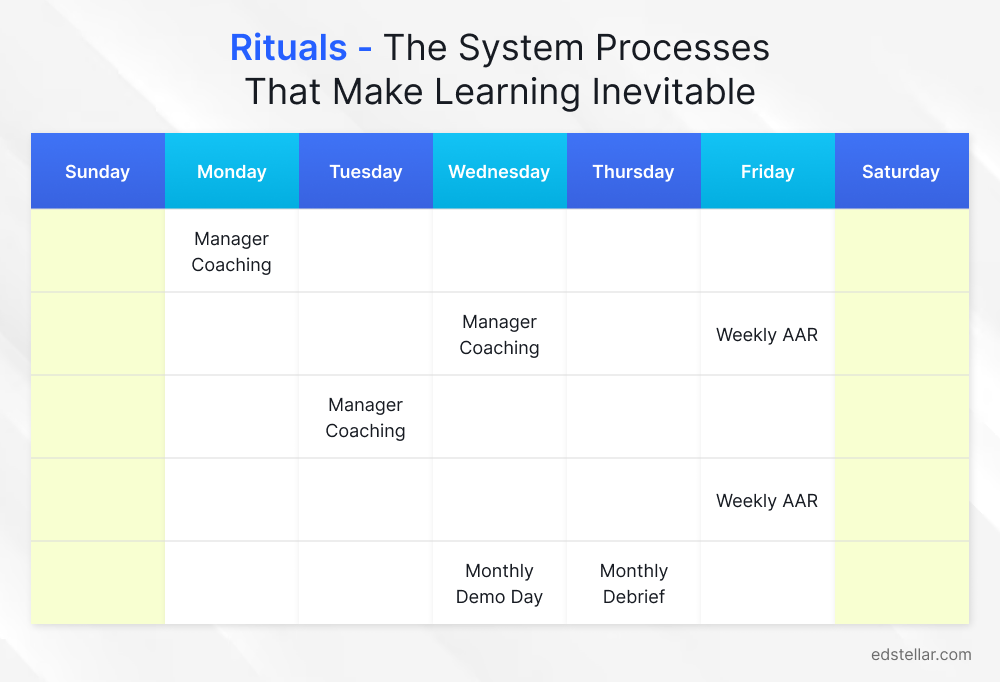
1. Weekly After-Action Review (AAR):
A 20–30 minute, blameless debrief that explores four questions:
- What did we intend?
- What happened?
- What worked and why?
- What will we change?
This ritual improves learning velocity and reduces repeat errors, converting experience into reusable insight.
2. Monthly Failure-to-Learning Debrief:
A short, transparent session where teams share “3 Do’s and 3 Don’ts” from a missed goal or experiment.
It normalizes smart risk-taking and strengthens psychological safety, the foundation of innovation and continuous improvement.
3. Weekly Manager 10-Minute Coaching:
A focused one-on-one conversation anchored on three prompts:
- What did you try?
- What did you learn?
- What’s your next rep?
Consistency compounds. Over time, this ritual sustains engagement and converts new knowledge into visible performance improvements.
4. Monthly Demo Day / Show-the-Work:
Teams host 4-6 short demos to showcase learnings, innovations, or solutions. Artifacts are captured, tagged, and reused, accelerating time-to-proficiency and building organizational memory.
These forums shift learning from private reflection to shared practice, from individual growth to collective evolution.
5. Daily Micro-Learning Nudges:
Two- to three-minute insights or prompts delivered directly inside Teams, Slack, or CRM tools, triggered by real work events.
These micro-moments reinforce learning in the flow of work, ensuring growth happens continuously, not episodically.
Part 3: Metrics The System Dashboard
What repeats should be measured, or it will regress to the mean.
Metrics are the telemetry of your Learning Culture Operating System (LCOS). They reveal whether learning is spreading, capability is compounding, and culture is generating measurable business value.
A healthy OS balances three categories of signals: Leading (adoption), Mid-Term (capability), and Lagging (business impact).
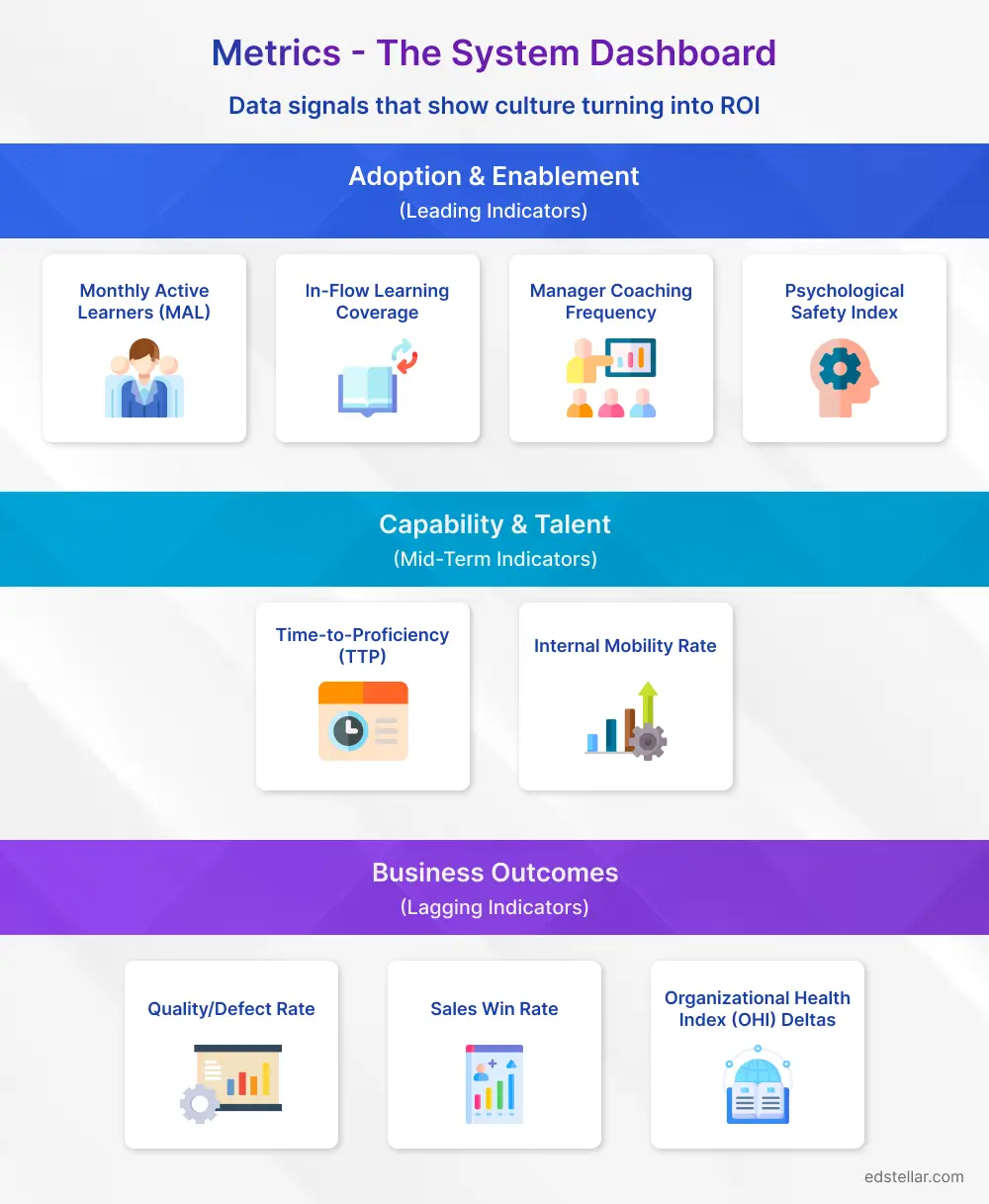
1. Adoption & Enablement: Leading Indicators
These metrics show whether learning behaviors and rituals are taking hold across the workforce.
- Monthly Active Learners (MAL): Percentage of unique employees engaging in learning activities. Rising MAL indicates cultural activation and curiosity at scale.
- In-Flow Learning Coverage: Percentage of learning delivered inside work tools (Teams, CRM, etc.). Measures how much learning happens in the flow of work, not outside of it.
- Manager Coaching Frequency: Average number of coaching touchpoints per employee per month. A leading signal of performance conversion.
- Psychological Safety Index: Pulse survey using Amy Edmondson’s validated instrument. Higher scores predict stronger collaboration and experimentation.
2. Capability & Talent: Mid-Term Indicators
These reveal whether learning is converting into readiness and mobility.
- Time-to-Proficiency (TTP): Median days for new or transitioning employees to reach full role competency. A declining TTP indicates faster learning velocity.
- Internal Mobility Rate: Percentage of open roles filled internally, showing how effectively the organization redeploys its own talent.
3. Business Outcomes: Lagging Indicators
These connect learning culture to performance and shareholder value.
- Quality / Defect Rate: Reduction in operational errors or safety incidents tied to learning adoption.
- Sales Win Rate: Increase in conversions for enabled or coached teams.
- Organizational Health Index (OHI) Deltas: Movement across McKinsey’s OHI dimensions; top-quartile companies deliver ≈3× TSR vs. bottom quartile.
The CHRO’s 90-Day Playbook to Launch a Learning Culture Operating System
Building a Learning Culture Operating System (LCOS) is not a side project; it’s a 90-day cultural reboot that can be executed with focus and discipline.
Below is a practical, phased roadmap for CHROs to move from concept to institutional habit, and from design to full-scale deployment.
Phase 1 (Weeks 1 – 3): Diagnose & Design the System
Objective: Establish a clear baseline, identify cultural gaps, and design the LCOS architecture.
Key Actions:
- Baseline the Current State: Measure four core indicators: Monthly Active Learners (MAL), Time-to-Proficiency (TTP), Manager Coaching Frequency, and Psychological Safety Index. Use quick surveys and existing HR data to set measurable starting points.
- Select 4–5 Learning Rituals: From the LCOS model (AARs, Demo Days, Coaching Moments, Micro-Learning Nudges, etc.). Prioritize those that align with business priorities or known capability gaps.
- Define Ownership: Assign ritual leads (e.g., business heads, HRBPs, L&D managers) and clarify reporting cadence for adoption metrics.
- Design your Measurement Dashboard: Build a simple, shared Power BI / Tableau dashboard to track MAL, TTP, coaching touches, and safety scores.
Deliverables:
- Learning Culture Blueprint (1-page executive map): A concise visual outlining the organization’s learning behaviors, rituals, and metrics serving as the north star for all managers and business units.
- Baseline Metrics Dashboard: A clear snapshot of the organization’s starting point showing current Monthly Active Learners (MAL), Manager Coaching Frequency, Time-to-Proficiency, and Psychological Safety Index for transparency and tracking.
- Manager Alignment Toolkit: A short briefing document or presentation equipping managers with what’s changing, why it matters, and their specific role in piloting the LCOS.
Signals of Progress:
- Visible Leadership Advocacy: Senior leaders begin referencing learning and reflection behaviors in meetings or communications.
- Ownership Clarity: Every ritual and metric now has an accountable owner with a defined cadence of reporting.
- Baseline Data Visualized: Initial dashboard shows current MAL, coaching frequency, and safety scores ready for tracking deltas in Phase 2.
- Early Psychological Buy-In: Managers and teams show openness to pilot participation and dialogue around learning behaviors.
Phase 2 (Weeks 4 – 8): Pilot & Instrument for Feedback
Objective: Test rituals in two pilot functions, embed learning into workflows, and establish data feedback loops.
Key Actions:
- Run Dual Pilots: One in a knowledge-based function (e.g., sales or marketing) and one in a frontline function (e.g., operations or service) to validate LCOS adaptability across roles.
- Activate in-flow Learning: Deliver micro-nudges and learning prompts directly inside Teams, Slack, or CRM tools, triggered by real work events. (Example: after a customer call, prompt “Reflect: What went well?”)
- Launch Learning Rituals: Conduct weekly After-Action Reviews (AARs) and 10-minute manager coaching sessions. Track participation, completion, and sentiment.
- Create a “Wins & Lessons” Channel: Use Teams or Slack to share weekly learnings and normalize open knowledge exchange.
- Collect Quick Feedback: Run short biweekly pulse surveys to measure engagement, effort, and perceived value.
Deliverables:
- Active LCOS Pilot running in two business units
- Initial data view of MAL, Coaching Frequency, and Safety Index
- Case examples highlighting early improvements in speed, quality, or collaboration
Signals of Progress:
- Pilot participation exceeds 60%
- Early anecdotal stories of behavioral shift
- Baseline metrics showing a positive trend
Phase 3 (Weeks 9 – 12): Review, Optimize & Scale
Objective: Evaluate impact, refine rituals, and scale the LCOS across the organization.
Key Actions:
- Analyze the Data: Compare pre- and post-pilot deltas for MAL, Coaching Frequency, TTP, and Quality Rates.
- Identify High-Impact Rituals: Determine which rituals drove the greatest improvements.
- Refine and Retire: Optimize effective rituals, adjust low-performers, and sunset those that didn’t drive measurable change.
- Scale Enterprise-Wide: Roll out the refined LCOS to remaining functions with updated playbooks and digital toolkits.
- Train Line Managers as Multipliers: Conduct short workshops to help managers coach, host AARs, and track learning data autonomously.
- Report to the C-Suite: Present a 90-day impact summary linking LCOS outcomes to engagement, productivity, or retention KPIs.
Deliverables:
- LCOS Scale-Up Playbook (final version)
- Enterprise Dashboard with updated metrics
- Executive Impact Report for CEO or Board review
Signals of Progress:
- 10 – 15 % improvement in Time-to-Proficiency
- Increased Manager Coaching touchpoints per month
- Visible leadership endorsement and cross-functional adoption
How Edstellar Enables the Learning OS?
Designing a Learning Culture Operating System (LCOS) is one thing; installing it across an organization requires expertise, technology, and cultural precision. It involves wiring new behaviors, rituals, and metrics into the flow of everyday work.
That’s where Edstellar partners with CHROs and L&D leaders to bridge the gap between strategy and execution.
At Edstellar, we go beyond training delivery. We build the systems, skills, and structures that make learning measurable, repeatable, and self-sustaining.
1. Learning Culture OS Design
We co-design your organization’s learning architecture, defining the behaviors, rituals, and metrics that form the foundation of your LCOS.
Our experts help you deploy these elements through governance models and live KPI dashboards that connect culture metrics directly to business outcomes.
2. Flow-of-Work Enablement
Using Edstellar’s digital learning infrastructure and integration capabilities, we help you embed learning directly where work happens inside tools like Teams, Slack, or CRMs.
We design learning sprints, micro-nudges, and workflow-based prompts that make learning inevitable rather than interruptive.
3. Leader Development
We strengthen the leadership behaviors that sustain learning. Through our leadership excellence program, we equip managers to cultivate psychological safety, coach consistently, and make better, evidence-based decisions so the learning system endures long after rollout.
4. L&D Consulting & Skill Intelligence
As part of Edstellar’s L&D Consulting Services, we help organizations align their learning culture with business and talent strategy while integrating Skill Intelligence to measure and optimize workforce capability.
Our Integrated Suite Includes:
- Training Needs Analysis (TNA): Diagnose real skill requirements and learning gaps.
- Skill Matrix Software: Map employee capabilities, identify gaps, and prioritize development using data-driven insights.
- Competency Framework Design, L&D Strategy Development, Learning Technology Advisory, and Performance–Learning Alignment.
Together, these solutions enable CHROs to design evidence-based learning strategies, quantify workforce capability, and direct training investments where they deliver the greatest impact.
Edstellar provides a one-stop ecosystem for every learning and development requirement, from diagnostics to execution.
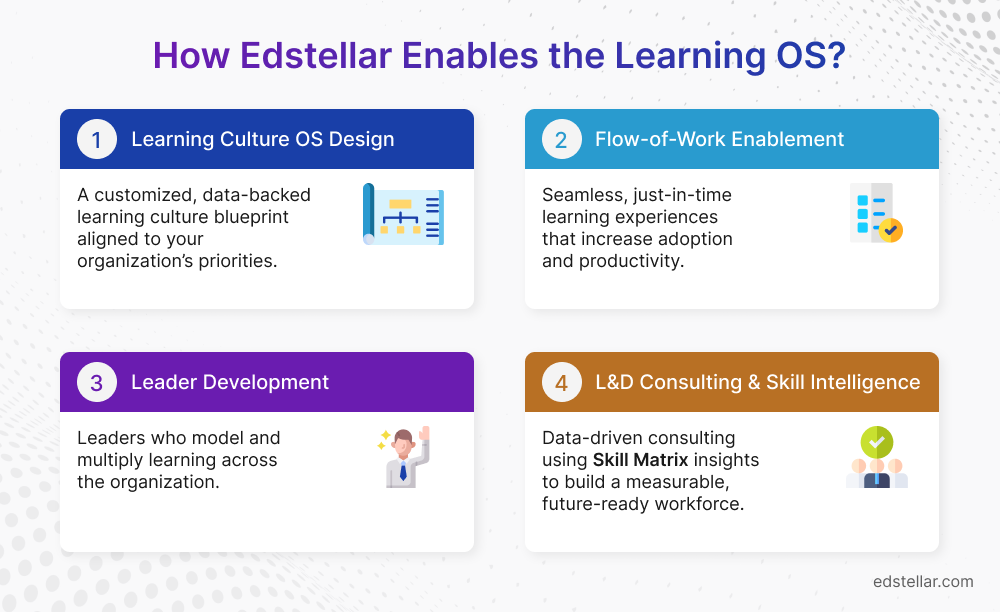
Conclusion: Engineering Your Advantage
A learning culture is not a soft concept. It is a hard, operational advantage built on a system of behaviors, rituals, and metrics.
As the CHRO, you are not just the steward of culture; you’re the architect of capability.
By installing a Learning Culture Operating System (LCOS), you move beyond advocating for learning; you engineer it into every process, conversation, and decision your organization makes.
When this system runs well, your organization doesn’t just respond to change; it learns faster than the market shifts.
That is what true resilience looks like.
Explore High-impact instructor-led training for your teams.
#On-site #Virtual #GroupTraining #Customized

Bridge the Gap Between Learning & Performance
Turn Your Training Programs Into Revenue Drivers.
Schedule a ConsultationEdstellar Training Catalog
Explore 2000+ industry ready instructor-led training programs.

Coaching that Unlocks Potential
Create dynamic leaders and cohesive teams. Learn more now!

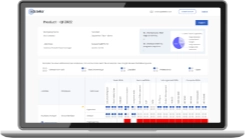
Want to evaluate your team’s skill gaps?
Do a quick Skill gap analysis with Edstellar’s Free Skill Matrix tool

Transform Your L&D Strategy Today
Unlock premium resources, tools, and frameworks designed for HR and learning professionals. Our L&D Hub gives you everything needed to elevate your organization's training approach.
Access L&D Hub Resources.svg)
.svg)



.svg)




.svg)
.svg)
.svg)
.svg)

